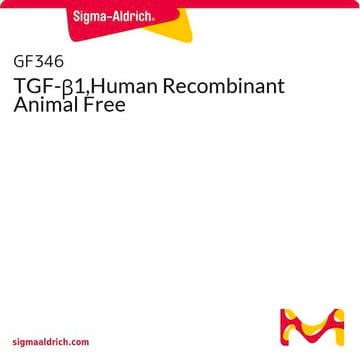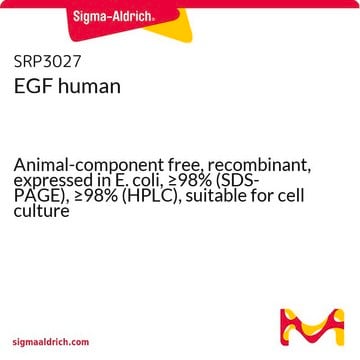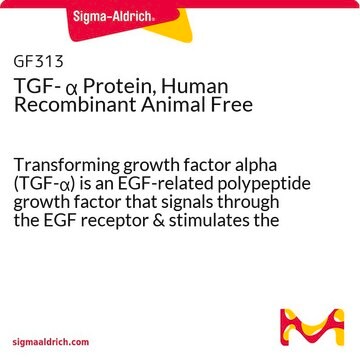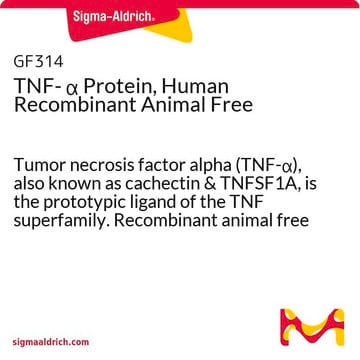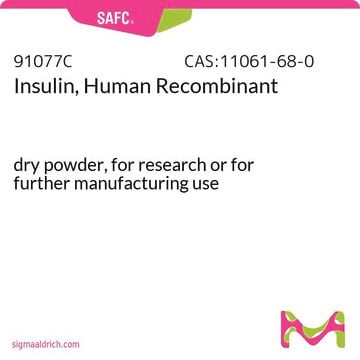Kluczowe dokumenty
H8541
Transforming Growth Factor-β1 human
≥95% (SDS-PAGE), recombinant, expressed in HEK 293 cells, lyophilized powder, suitable for cell culture
Synonim(y):
TGF-β1
Wybierz wielkość
1480,00 zł
Wybierz wielkość
About This Item
1480,00 zł
Polecane produkty
Nazwa produktu
Transforming Growth Factor-β1 human, TGF-β1, Xeno-free, recombinant, expressed in HEK 293 cells, suitable for cell culture
pochodzenie biologiczne
human
Poziom jakości
rekombinowane
expressed in HEK 293 cells
Próba
≥95% (SDS-PAGE)
Formularz
lyophilized powder
siła działania
≤0.5 ng/mL EC50
jakość
endotoxin tested
masa cząsteczkowa
dimer 25 kDa (non-glycosylated)
opakowanie
pkg of 5 μg
warunki przechowywania
avoid repeated freeze/thaw cycles
metody
cell culture | mammalian: suitable
zanieczyszczenia
≤1 EU/μg
numer dostępu UniProt
temp. przechowywania
-10 to -25°C
informacje o genach
human ... TGFB1(7040)
Szukasz podobnych produktów? Odwiedź Przewodnik dotyczący porównywania produktów
Opis ogólny
Zastosowanie
- to study the expression of PDGFRB (Platelet derived growth factor receptor β) in association with transforming growth factor-β signaling.[4]
- to stimulate lung fibrosis in human fetal lung fibroblast cell line in order to further measure the in-plane elasticity of live cell layers using a pressure sensor embedded microfluidic device.[5]
- to study the effect of TGF-β on HTRA1 (high-temperature requirement A1)-affected Wnt target genes.[6]
Działania biochem./fizjol.
Postać fizyczna
Komentarz do analizy
Hasło ostrzegawcze
Danger
Zwroty wskazujące rodzaj zagrożenia
Zwroty wskazujące środki ostrożności
Klasyfikacja zagrożeń
Eye Dam. 1 - Skin Corr. 1B
Kod klasy składowania
8A - Combustible corrosive hazardous materials
Klasa zagrożenia wodnego (WGK)
WGK 2
Temperatura zapłonu (°F)
Not applicable
Temperatura zapłonu (°C)
Not applicable
Wybierz jedną z najnowszych wersji:
Certyfikaty analizy (CoA)
Nie widzisz odpowiedniej wersji?
Jeśli potrzebujesz konkretnej wersji, możesz wyszukać konkretny certyfikat według numeru partii lub serii.
Masz już ten produkt?
Dokumenty związane z niedawno zakupionymi produktami zostały zamieszczone w Bibliotece dokumentów.
Klienci oglądali również te produkty
Produkty
Discover answers to your frequently asked questions about animal component-free, xenobiotic-free, and chemically defined media and reagents for cell culture.
Powiązane treści
Discover cancer research resources with modeling and profiling tools for cell culture, genomics, biomarkers, and more to help maximize your cancer research.
Odkryj zasoby do badań nad rakiem z narzędziami do modelowania i profilowania hodowli komórkowych, genomiki, biomarkerów i nie tylko, aby zmaksymalizować swoje badania nad rakiem.
Active Filters
Nasz zespół naukowców ma doświadczenie we wszystkich obszarach badań, w tym w naukach przyrodniczych, materiałoznawstwie, syntezie chemicznej, chromatografii, analityce i wielu innych dziedzinach.
Skontaktuj się z zespołem ds. pomocy technicznej
